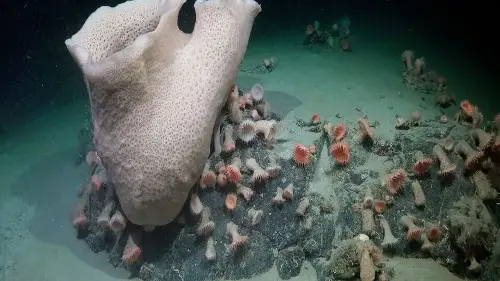
A team of scientists has uncovered a never-before-seen Antarctic ecosystem after a massive ice shelf collapse exposed a previously inaccessible seafloor. The discovery, made by researchers aboard the "R/V Falkor (too)" in January 2025, provides a rare opportunity to study life beneath the ice.
A rare opportunity for exploration
The Schmidt Ocean Institute team was conducting research when a piece of ice the size of Chicago broke off from the George VI Ice Shelf, located 57 miles away.
"We seized the moment"
Expedition co-chief scientist Dr. Patricia Esquete of the Centre for Environmental and Marine Studies (CESAM) at the University of Aveiro, Portugal, emphasized the significance of the opportunity.
“We seized upon the moment, changed our expedition plan, and went for it so we could look at what was happening in the depths below,” Esquete said. “We didn’t expect to find such a beautiful, thriving ecosystem. Based on the size of the animals, the communities we observed have been there for decades, maybe even hundreds of years.”
Using Schmidt Ocean Institute’s ROV SuBastian, the team conducted eight days of exploration at depths reaching 1,300 meters. The expedition revealed a thriving deep-sea ecosystem, including large corals, sponges, icefish, giant sea spiders, and octopi. The discovery has provided valuable insights into life beneath the Antarctic ice sheet.
A thriving and mysterious ecosystem
The team was surprised by the biodiversity and abundance of life beneath the ice shelf. Scientists suspect that several previously unknown species may have been discovered during the expedition.
One of the key questions researchers are now investigating is how these ecosystems sustain themselves. Typically, deep-sea life depends on nutrients from surface waters slowly sinking to the ocean floor. However, this region had been covered by an ice sheet 150 meters thick, cutting it off from direct surface nutrient sources.
“Ocean currents also move nutrients, and we hypothesize that currents are a possible mechanism for sustaining life beneath the ice sheet,” Esquete explained. “The precise mechanism fueling these ecosystems is not yet understood.”
Implications for climate change research
The newly exposed Antarctic seafloor is also providing valuable data on past and present changes in the Antarctic ice sheet. Researchers from Portugal, the United Kingdom, Chile, Germany, Norway, New Zealand, and the United States collected critical information about ice loss trends, which could improve predictions of future climate change impacts.
“The ice loss from the Antarctic Ice Sheet is a major contributor to sea level rise worldwide,” said expedition co-chief scientist Sasha Montelli of University College London (UCL), a 2019 Schmidt Science Fellow. “Our work is critical for providing longer-term context of these recent changes, improving our ability to make projections of future change—projections that can inform actionable policies. We will undoubtedly make new discoveries as we continue to analyze this vital data.”
A rare scientific opportunity
Dr. Jyotika Virmani, Executive Director of Schmidt Ocean Institute, highlighted the rare opportunity presented by the iceberg’s sudden calving.
“The science team was originally in this remote region to study the seafloor and ecosystem at the interface between ice and sea,” Virmani said. “Being right there when this iceberg calved from the ice shelf presented a rare scientific opportunity. Serendipitous moments are part of the excitement of research at sea—they offer the chance to be the first to witness the untouched beauty of our world.”
As researchers continue to analyze their findings, the discovery of this hidden Antarctic ecosystem is expected to provide groundbreaking insights into the resilience of marine life in extreme environments and the broader implications of climate change on the world’s oceans.